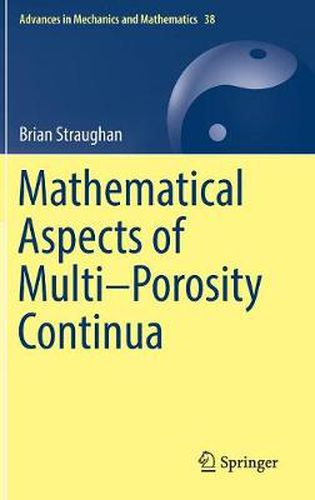Readings Newsletter
Become a Readings Member to make your shopping experience even easier.
Sign in or sign up for free!
You’re not far away from qualifying for FREE standard shipping within Australia
You’ve qualified for FREE standard shipping within Australia
The cart is loading…






This title is printed to order. This book may have been self-published. If so, we cannot guarantee the quality of the content. In the main most books will have gone through the editing process however some may not. We therefore suggest that you be aware of this before ordering this book. If in doubt check either the author or publisher’s details as we are unable to accept any returns unless they are faulty. Please contact us if you have any questions.
This book is devoted to describing theories for porous media where such pores have an inbuilt macro structure and a micro structure. For example, a double porosity material has pores on a macro scale, but additionally there are cracks or fissures in the solid skeleton. The actual body is allowed to deform and thus the underlying theory is one of elasticity. Various different descriptions are reviewed.
Chapter 1 introduces the classical linear theory of elastodynamics together with uniqueness and continuous dependence results. Chapters 2 and 3 review developments of theories for double and triple porosity using a pressure-displacement structure and also using voids-displacement. Chapter 4 compares various aspects of the pressure-displacement and voids-displacement theories via uniqueness studies and wave motion analysis. Mathematical analyses of double and triple porosity materials are included concentrating on uniqueness and stability studies in chapters 5 to 7. In chapters 8 and 9 the emphasis is on wave motion in double porosity materials with special attention paid to nonlinear waves. The final chapter embraces a novel area where an elastic body with a double porosity structure is analyzed, but the thermodynamics allows for heat to travel as a wave rather than simply by diffusion. This book will be of value to mathematicians, theoretical engineers and other practitioners who are interested in double or triple porosity elasticity and its relevance to many diverse applications.
$9.00 standard shipping within Australia
FREE standard shipping within Australia for orders over $100.00
Express & International shipping calculated at checkout
This title is printed to order. This book may have been self-published. If so, we cannot guarantee the quality of the content. In the main most books will have gone through the editing process however some may not. We therefore suggest that you be aware of this before ordering this book. If in doubt check either the author or publisher’s details as we are unable to accept any returns unless they are faulty. Please contact us if you have any questions.
This book is devoted to describing theories for porous media where such pores have an inbuilt macro structure and a micro structure. For example, a double porosity material has pores on a macro scale, but additionally there are cracks or fissures in the solid skeleton. The actual body is allowed to deform and thus the underlying theory is one of elasticity. Various different descriptions are reviewed.
Chapter 1 introduces the classical linear theory of elastodynamics together with uniqueness and continuous dependence results. Chapters 2 and 3 review developments of theories for double and triple porosity using a pressure-displacement structure and also using voids-displacement. Chapter 4 compares various aspects of the pressure-displacement and voids-displacement theories via uniqueness studies and wave motion analysis. Mathematical analyses of double and triple porosity materials are included concentrating on uniqueness and stability studies in chapters 5 to 7. In chapters 8 and 9 the emphasis is on wave motion in double porosity materials with special attention paid to nonlinear waves. The final chapter embraces a novel area where an elastic body with a double porosity structure is analyzed, but the thermodynamics allows for heat to travel as a wave rather than simply by diffusion. This book will be of value to mathematicians, theoretical engineers and other practitioners who are interested in double or triple porosity elasticity and its relevance to many diverse applications.